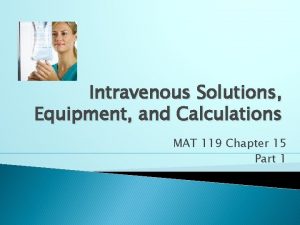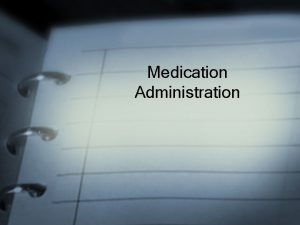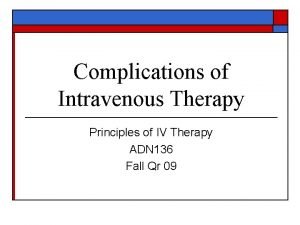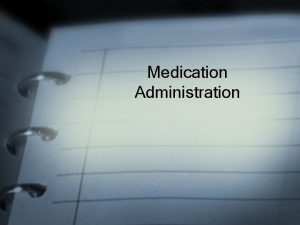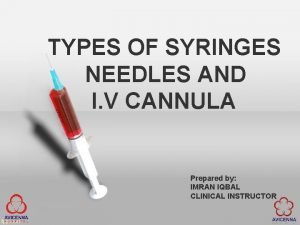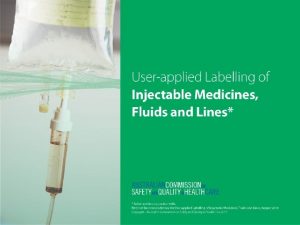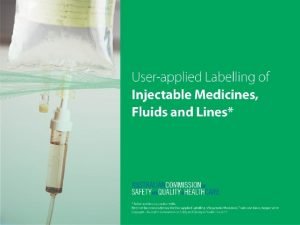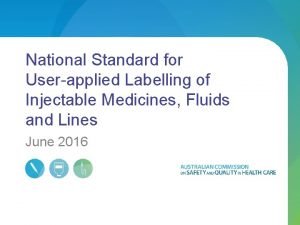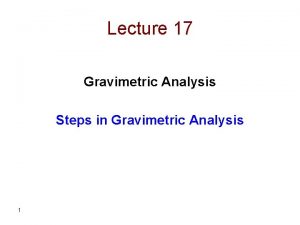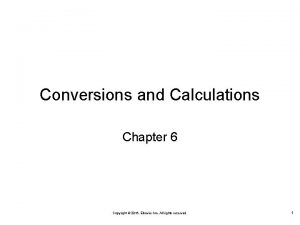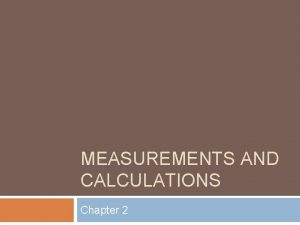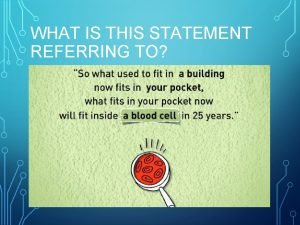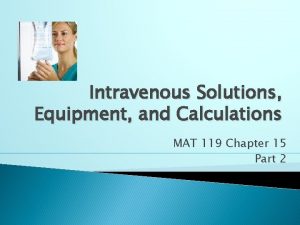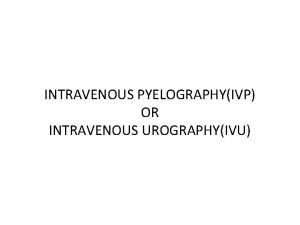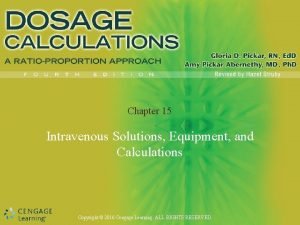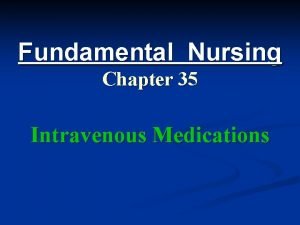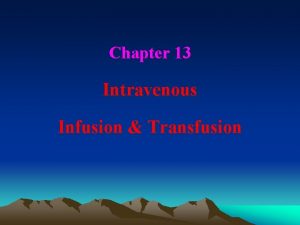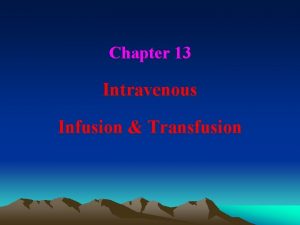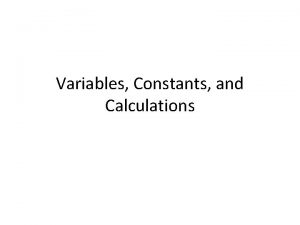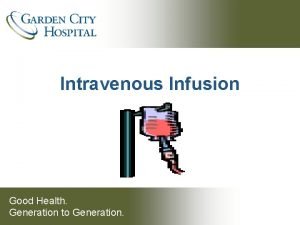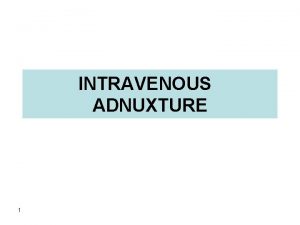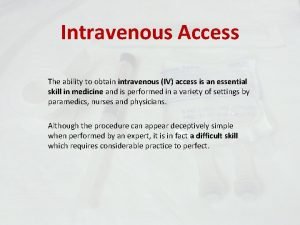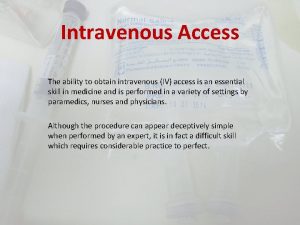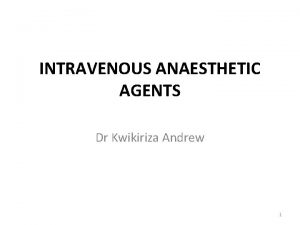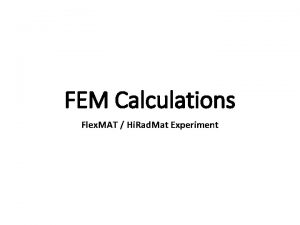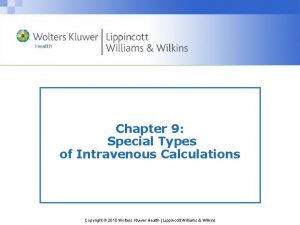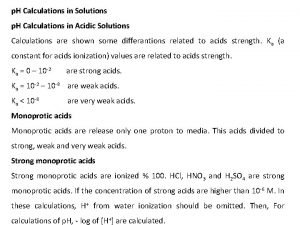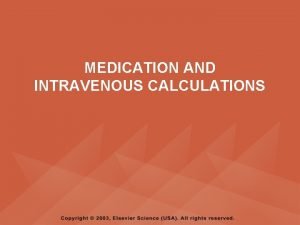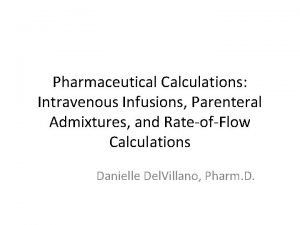Intravenous Solutions Equipment and Calculations MAT 119 Chapter






































- Slides: 38

Intravenous Solutions, Equipment, and Calculations MAT 119 Chapter 15 Part 1

IV Components Abbreviation Solution Component D Dextrose W Water S Saline NS Na. Cl Normal Saline (0. 9% sodium chloride) Sodium Chloride RL Ringer’s Lactate LR Lactated Ringer’s

Solution Strength The abbreviation letters indicate the solution components The numbers indicate the solution strength or concentration of the components. Examples: D 5 W, D 5 NS, D 10 W 3

Examples of Solution Strength D 5 W – means dextrose 5% in water ◦ 5% Dextrose Injection (p. 357 figure 15. 1) ◦ This means the solution strength of the solute (dextrose) is 5%. ◦ The solvent is water ◦ Each 100 m. L of water contains 5 g of dextrose 5% = 5 g 100 m. L 4

Examples of Solution Strength An order states: D 5 NS 1000 m. L IV over 8 h ◦ Interpretation: Administer 1000 m. L 5% dextrose in 0. 9% sodium chloride over 8 hrs. ◦ Supplied as 5% dextrose and 0. 9% sodium chloride (Na. Cl) ◦ Normal Saline is a common term for 0. 9% sodium chloride ◦ The concentration of sodium chloride in normal saline is 0. 9 g (or 900 mg) per 100 m. L of solution ◦ If the concentration is NOT 0. 9%, it is NOT normal saline! It is sodium chloride! 5

Normal Saline continued 0. 45% Na. Cl or written ½ NS ◦ This is ½ strength of 0. 9% sodium chloride ◦ This solution is sodium chloride! 0. 225% Na. Cl or written ¼ NS ◦ This is ¼ strength of 0. 9% sodium chloride ◦ This solution is sodium chloride! 6

IV fluids are ordered for the following purposes: To maintain fluid balance (replace insensible water losses + sweat + urine output when patients are NPO or otherwise unable to drink as much as they need to for replacement) To replace volume losses (i. e. , blood volume loss due to surgery, losses from the GI tract from vomiting or diarrhea) To repair imbalances (electrolyte imbalances, acidosis/alkalosis). 7

IV Solutions 8

IV Solutions Isotonic solutions are NS and LR. These solutions have the same osmolarity of blood so when you administer them IV, the fluid stays in the vascular system re-expanding it. Hypertonic solutions are high osmolarity solutions. Greater than 0. 9% sodium chloride (NS) 3% & 5% NS Greater than Dextrose 5%, like D 25 W or D 50 W, and D 5 plus any other solutions, like D 5 LR, D 5 NS, D 5 1/2 NS etc. 9

IV Solutions Hypotonic solutions are watery solutions. ◦ These are solutions less than 0. 9% sodium chloride (NS) and D 5 W. ◦ D 5 W when it enters the blood stream has the dextrose metabolized leaving water behind to seep out to the cells. 10

IV Solution Label 11

IV Sites Peripheral ◦ Rate of infusion should not exceed ~200 m. L/h ◦ Maximum glucose concentration is 12% Central line ◦ larger vein usually in chest (ex. Subclavian, jugular in neck) ◦ Accommodates larger concentrations and volumes of fluid PICC line ◦ A peripheral vein used to access a central vein 12

Peripheral IV site intensivecare. hsnet. nsw. gov. au www. smith-nephew. com 13

Arterial port or Port-a-cath jpizzlll. org bobcowart. blogspot. com Breastcancer. about. com Phoenix 5. org 14

Ash catheter and Internal jugular catmancando. blogspot. com kidney-beans. blogspot. com 15

PICC Line jmmultiplemyeloma. blogspot. com www. drypro. ie www. cs. cmu. edu 16

IV Sites The nurse is responsible for monitoring the patient and IV site Complications ◦ Phlebitis – the vein becomes irritated, red, painful, warm and cordlike ◦ Infiltration – the IV catheter becomes dislodged from the vein & the IV fluid infuses into the subcutaneous tissue (cool and puffy skin) ◦ Infection – sites need to be changed per hospital policy 17

Standard Straight Gravity Flow IV 18

IV with Piggyback (IV PB) 19

IV Infusion Pumps 20

IV Flow Rate Ordered by physician Nurse’s responsibility to regulate, monitor, and maintain flow rate 2 definitions: ◦ m. L/hr – an infusion pump ◦ gtt/min – manually counted (watch count) 21

Formulas Made Easy! Pump: m. L/h > 1 hr: total m. L = m. L/hr total hr < 1 hr: total m. L x 60 min/hr = m. L/hr total min Drops per Min: gtt/min total m. L x drop factor gtt/m. L = gtt/min total min

IV Flow Rate: m. L per hour > 1 hr: Regulate an IV volume by electronic infusion pump or controller calibrated in m. L per hour THINK: the design of the pumps is to be set in ml/hr ONLY (rounded to a whole number) “Review rules of rounding”

Calculation of IV Flow Rate: m. L per hour Order reads: D 5 W 250 m. L IV over the next two hours by infusion pump 24

IV Flow Rate: m. L per hour • Use one of the formulas: Volume Time Ratio/Proportion Total volume (m. L) Total time (hours) – Therefore, set pump at 125 m. L per hour 125 m. L/h

IV Flow Rate in m. L per hour: Infusion Rate is less than 1 hour (rounded to a whole number) 26

Calculation of m. L per hour: Infusion Rate is less than 1 hour Order: ◦ Ampicillin 500 mg IV in 50 m. L D 5 NS in 30 min by controller ◦ (Note: physician’s orders will not state to use an infusion pump, controller or drop factor; this is done for the purpose of understanding how in infuse medications. ) 27

Calculation of m. L per hour: Infusion Rate is less than 1 hour Calculate

Manually Regulated IVs If an infusion pump is not used, the nurse must calculate the ordered IV rate Based on the number of drops per minute (gtt/min) The gravity flow rate depends in the IV tubing calibration called the drop factor (gtt/m. L) Answer MUST be in a whole number! 29

Drop Factors The drop factor is the number of drops per milliliter (gtt/m. L) that an IV tubing set will deliver Standard or MACROdrop IV tubing has a drop factor of 10, 15, or 20 gtt/m. L MICROdrop IV tubing has a drop factor of 60 gtt/m. L – used for infusion pumps 30

IV Flow Rate: Drops per min Formula for IV flow rate for manually regulated IVs ordered in m. L per hour or for minutes Volume (m. L) Calibration or drop factor (gtt/m. L) Time (min) Rate (gtt/min) 31

Formula for Infusion Time gtt/min Total m. L x drop factor gtt/m. L = gtts/min Time (in minutes) Example: 1000 m. L NS to run over 12 hours Tubing is 15 gtt/m. L = 20. 8 = 21 gtt/min 1000 ml x 15 gtt/m. L over 720 min = 15000/720 =15, 000 divided by 720 = 20. 8 = 21 gtt/min 32

IV Flow Rate: Drops per min Carry calculations to the tenths place Round drops per min to the nearest whole number Watch ◦ Count only whole drops 33

Calculation of gtt/min from m. L/hr Physician orders: ◦ D 5 W IV at 125 m. L per hour Infusion set is calibrated for a drop factor of 10 drops per m. L Calculate IV flow rate in drops per min 34

Calculation of gtt/min from m. L/hr Notice that the m. L and hr cancel out, leaving drops per min 125 m. L/hr x 10 gtt/m. L = 20. 8 gtt/min 60 min/hr Use your watch to count drops and adjust roller clamp to deliver 21 drops per min 35

Calculation of Drops per min: Microdrip Drop Factor When IV drop factor is 60 drops per m. L (microdrip sets) ◦ Flow rate in drops per min is same as volume ordered in m. L per hour 36

Calculation of Drops per min: Microdrip (60 gtt/m. L) Drop Factor Order: D 5 W NS IV at 50 m. L/hr Drop factor is 60 gtt/m. L Notice: order of 50 m. L/hr is the same as the flow rate of 50 gtt/min ONLY when drop factor is 60 drops per m. L 50 m. L/hr x 60 gtt/m. L ÷ 60 min/hr = 50 gtt/min 37

Practice Do not do shortcut method Do not do adjusting IV flow rate 38
 Mat 119
Mat 119 Iv drop factor
Iv drop factor Mat 119
Mat 119 Po bid pc
Po bid pc Structural steel connection calculations calculations
Structural steel connection calculations calculations Concepts of medication administration pretest
Concepts of medication administration pretest Iv cannulation procedure ppt
Iv cannulation procedure ppt Extravasation vs phlebitis
Extravasation vs phlebitis Medication administration 3 pretest
Medication administration 3 pretest Iv cannula parts
Iv cannula parts Iv cannula labelling
Iv cannula labelling Line & catheter label - intravenous burette
Line & catheter label - intravenous burette User applied labelling
User applied labelling Intravenous combining vowel
Intravenous combining vowel Gravimetric analysis calculations
Gravimetric analysis calculations Chapter 2 measurements and calculations
Chapter 2 measurements and calculations Conversions and calculations chapter 6
Conversions and calculations chapter 6 Percent error example
Percent error example Think pair and share page 119-120
Think pair and share page 119-120 Salmo 119 126
Salmo 119 126 Lei nº4.119/1962
Lei nº4.119/1962 Psaumes 119:9
Psaumes 119:9 Psalms 119:105 nlt
Psalms 119:105 nlt Psalm 119:9-11 kjv
Psalm 119:9-11 kjv Salmo 119:71-72
Salmo 119:71-72 Psalm 119 9 16
Psalm 119 9 16 Hpd 118 uitm
Hpd 118 uitm Psalm 119 meditation
Psalm 119 meditation Weather disturbances
Weather disturbances Psalm 119 verse 17-24
Psalm 119 verse 17-24 Psaumes 119:105
Psaumes 119:105 Psalm 119 summary
Psalm 119 summary Ontario's equity and inclusive education strategy
Ontario's equity and inclusive education strategy Psalm 119:9-16 nkjv
Psalm 119:9-16 nkjv Direct my steps by your word
Direct my steps by your word Psalm 119 overview
Psalm 119 overview Psalm 119 liedboek
Psalm 119 liedboek Psalm 119:160
Psalm 119:160 Salmo 119:99
Salmo 119:99

